Clearscope is one of the best-known names in SEO content optimization. Its clean interface, straightforward grading system, and keyword suggestions make it a favorite among writers and editors who want simple, reliable guidance.
But for many teams, Clearscope quickly shows its limits. It’s expensive and it lacks the automation, AI features, and collaboration tools that modern marketing teams need to scale.
If you’re running a lean team, publishing dozens of articles each month, or looking to build topical authority, Clearscope may feel like you’re paying more and getting less. That’s why many marketers look for alternatives that offer a deeper, more cost-effective solution.
1. Surfer
Surfer is a strong Clearscope alternative for teams that want to connect content optimization and strategy more directly to rankings.
While Clearscope focuses on keyword suggestions and a clean optimization workflow, Surfer takes the same foundation and builds it into a full-stack content optimization platform.
From planning to writing to post-publish monitoring, it’s designed for teams that want measurable SEO results in their content creation process, not just better drafts.
Main features:
- Content Editor – Real-time keyword, structure, and topical coverage guidance.
- Content Score – Independently validated, with a 0.28 correlation to Google rankings compared to Clearscope’s 0.17–0.18.
- Auto Optimize & Coverage Booster – One-click improvements to fill gaps and strengthen coverage.
- Internal linking – Automatic suggestions and insertion through Google Search Console.
- Topical Maps – Plan content clusters to build topical authority at scale.
- Content Audit – Identify underperforming pages and get recommendations to refresh them.
- AI Tracker – Monitor visibility across AI search platforms like Google’s AI Overviews, ChatGPT, and Perplexity.
What sets Surfer apart is that it doesn’t just tell you what to improve — it helps you implement changes directly in the Content Editor.
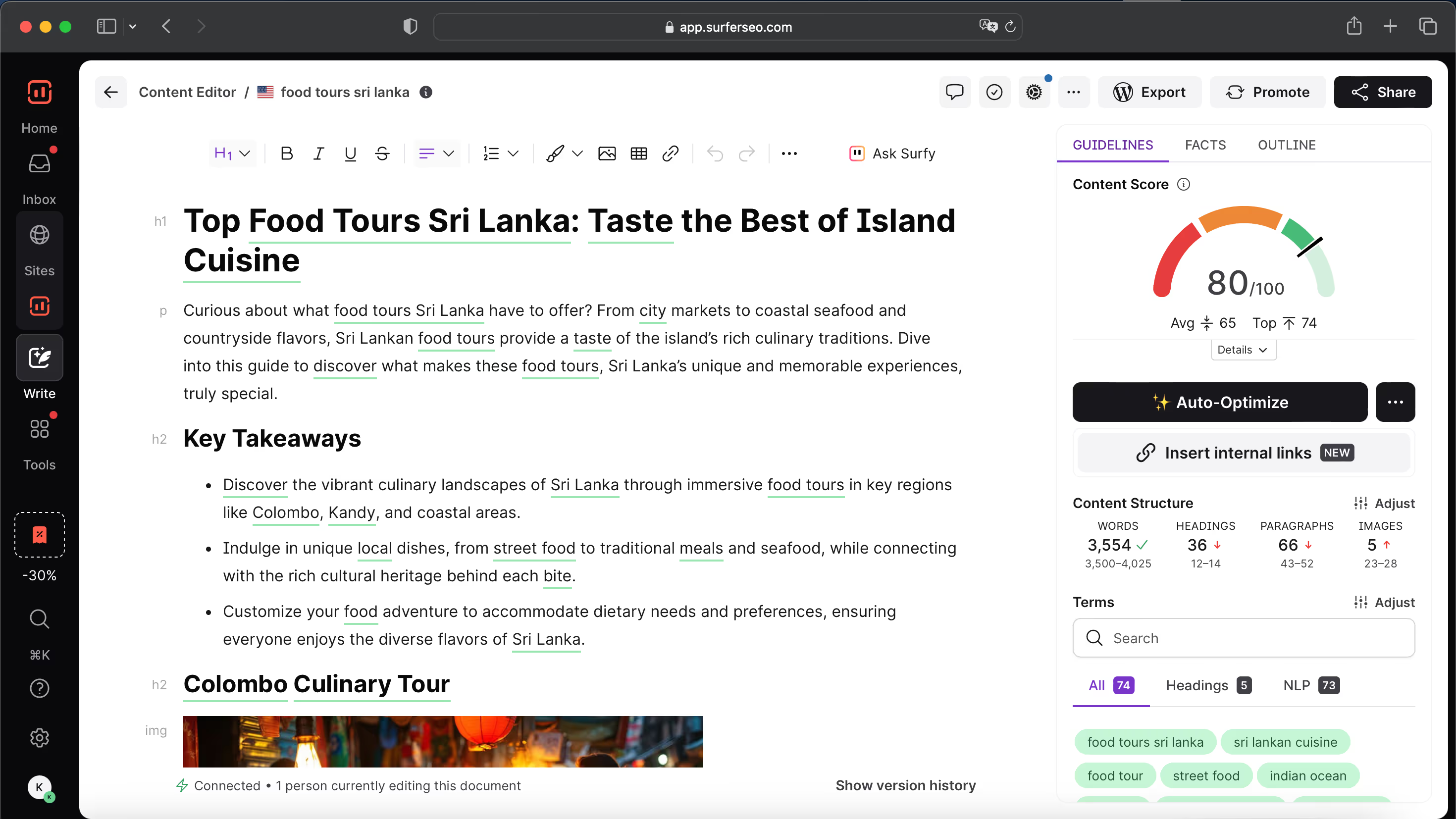
Auto Optimize, Coverage Booster, and one-click internal linking eliminate hours of manual work, making optimization far more efficient for growing teams.
The Content Score is another key differentiator. With independent studies showing a stronger correlation to rankings than Clearscope’s, it gives teams a reliable benchmark for their target keyword to decide when content is ready to compete in the SERPs.
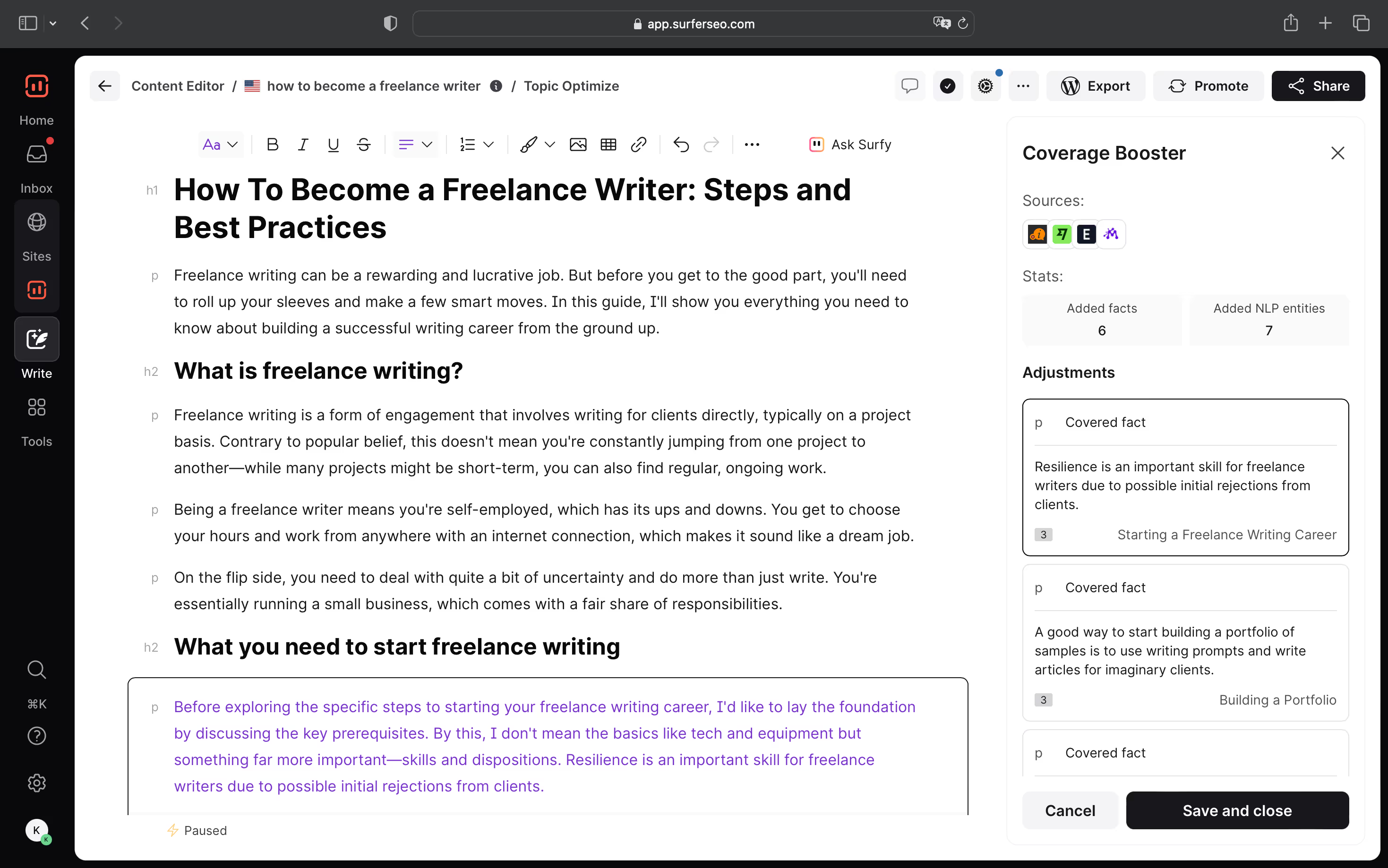
And as search evolves, Surfer goes further by offering features like AI Tracker. Instead of limiting your visibility to Google alone, it helps you understand how your brand shows up in emerging AI-driven search experiences, something Clearscope doesn’t currently support.
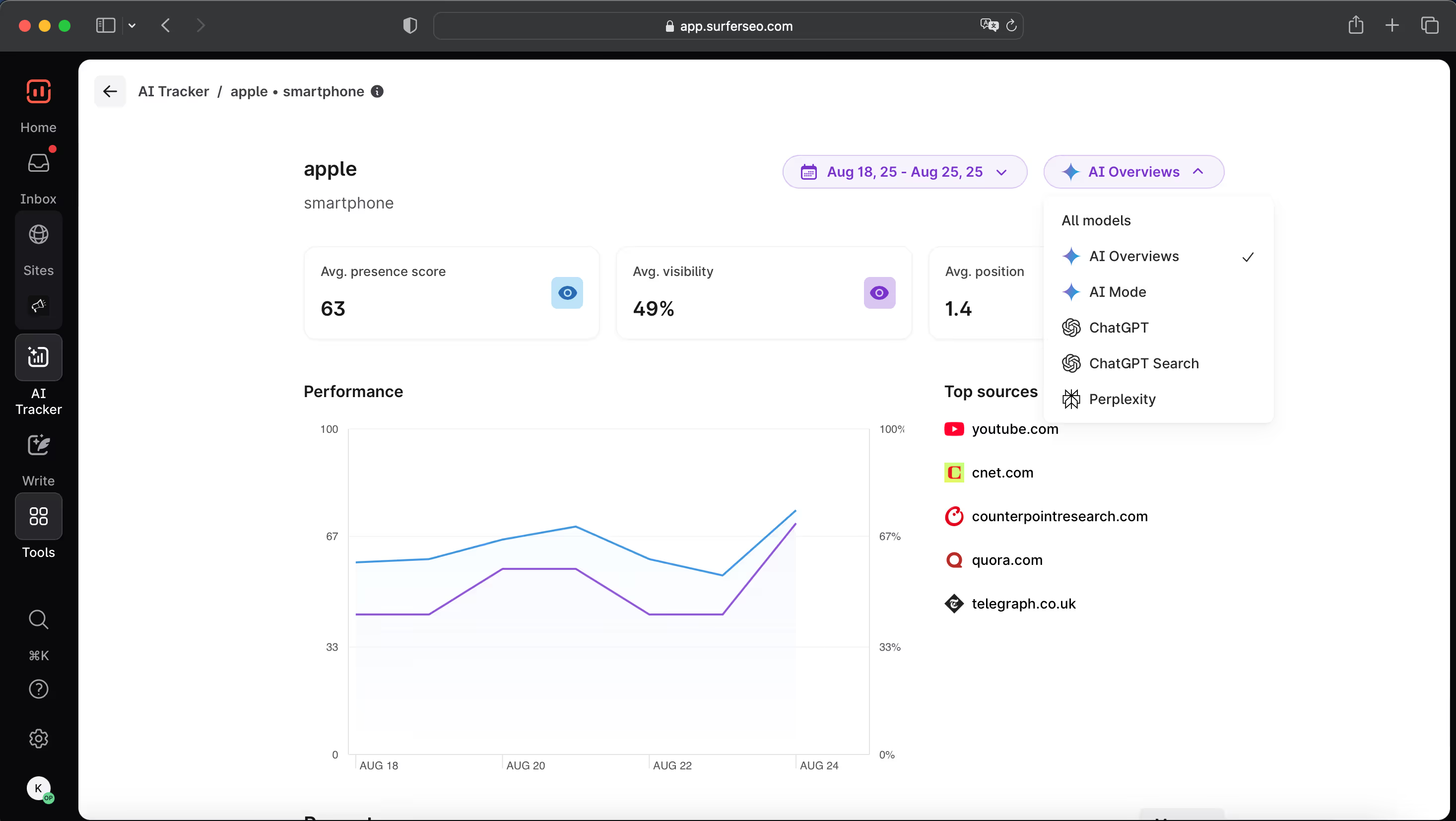
Best for: Teams that want to scale content production, strengthen topical authority, and stay ahead in both traditional and AI-driven search.
2. Frase
Frase is a budget-friendly content optimization tool that’s popular with solo creators and lean teams. It’s built for speed and simplicity—helping you move from research to draft quickly.
But while it’s great for getting content out the door, its limitations become clear when you’re aiming for long-term rankings and authority.
Main features:
- SERP analysis – Breaks down top-ranking pages with details like word count, headings, links, and domain authority.
- Content briefs – Automatically generates outlines, topic clusters, and competitor insights for each keyword.
- Content editor – Offers keyword suggestions, content scoring, and optimization recommendations.
- AI writing assistant – Can generate drafts, intros, FAQs, or rewrites with pre-set or custom prompts.
Frase works well as a fast-drafting tool in the writing process . Its SERP breakdowns and auto-generated briefs save time, and the AI assistant helps produce workable drafts quickly.
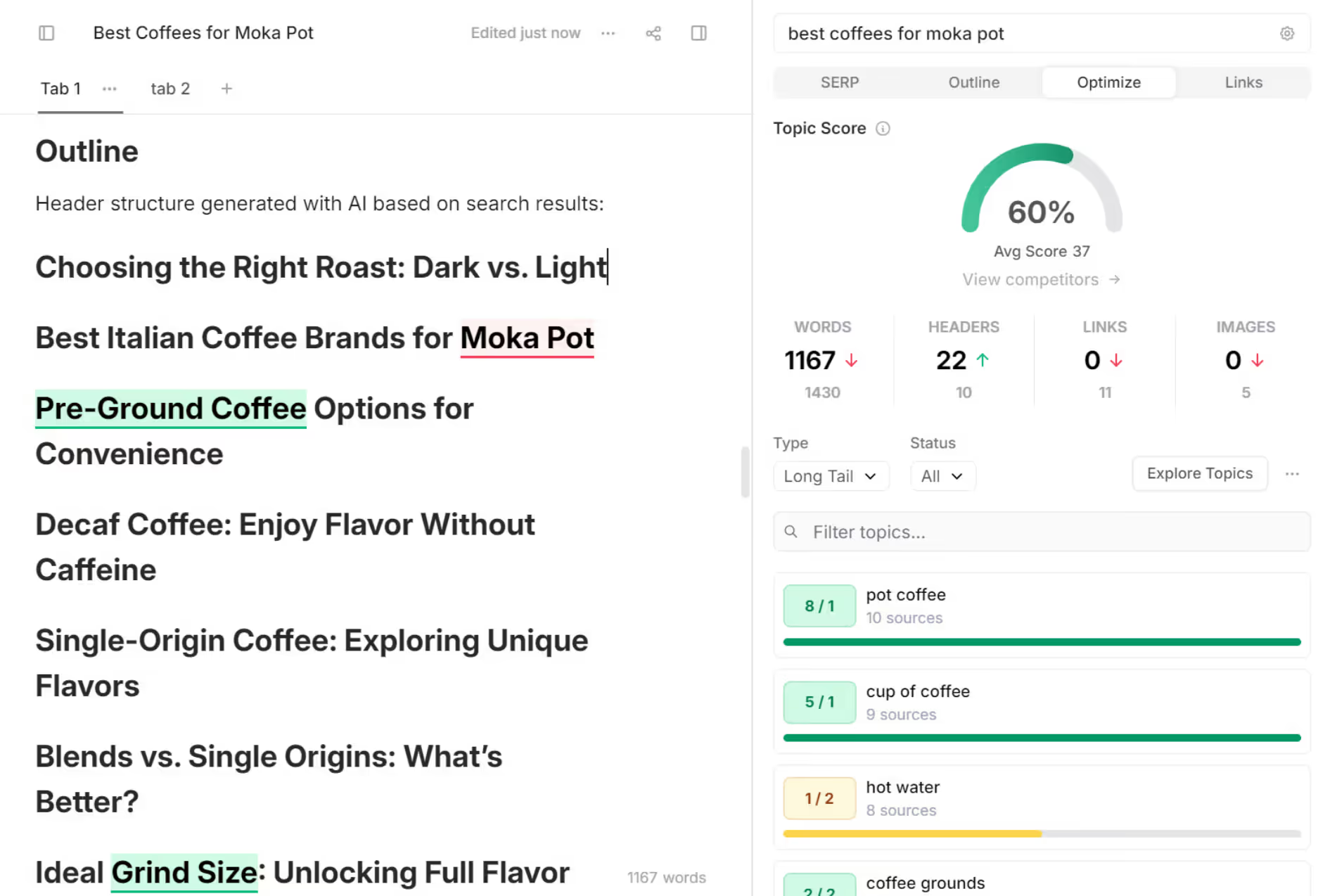
The limitation is in performance. Independent studies have shown Frase’s content score has little to no correlation with rankings (around 0.1 according to Ahrefs).
Add to that the lack of topical mapping, internal linking automation, and refresh workflows, and it becomes clear that Frase is better suited for speed than for scaling authority.
Best for: Freelancers and small teams who value speed and affordability over deeper optimization or reliable ranking impact.
3. MarketMuse
MarketMuse is one of the more strategic Clearscope alternatives, built for teams that want a solid content strategy with depth over simplicity.
Where Clearscope focuses on keyword coverage and a clean optimization workflow, MarketMuse expands into broader content planning, topic modeling, and inventory analysis.
But it also comes with a steeper learning curve and a much higher price point, which makes it less accessible for lean teams.
Main features:
- Content inventory – Audits your site, surfaces gaps, and recommends which pages to update or expand.
- Topic modeling – Suggests related terms, subtopics, and questions to build topical authority.
- AI content briefs – Detailed outlines with headings, FAQs, and competitor insights.
- SERP X-Ray & Topic Navigator – In-depth analysis of search results with ranking factors, CPC data, and intent.
- Heatmaps – Visual comparison showing how competitors cover supporting topics.
Compared to Clearscope, MarketMuse provides far richer strategic insight. Its Heatmaps and Topic Navigator make it clear where your content falls short and where competitors have the edge.
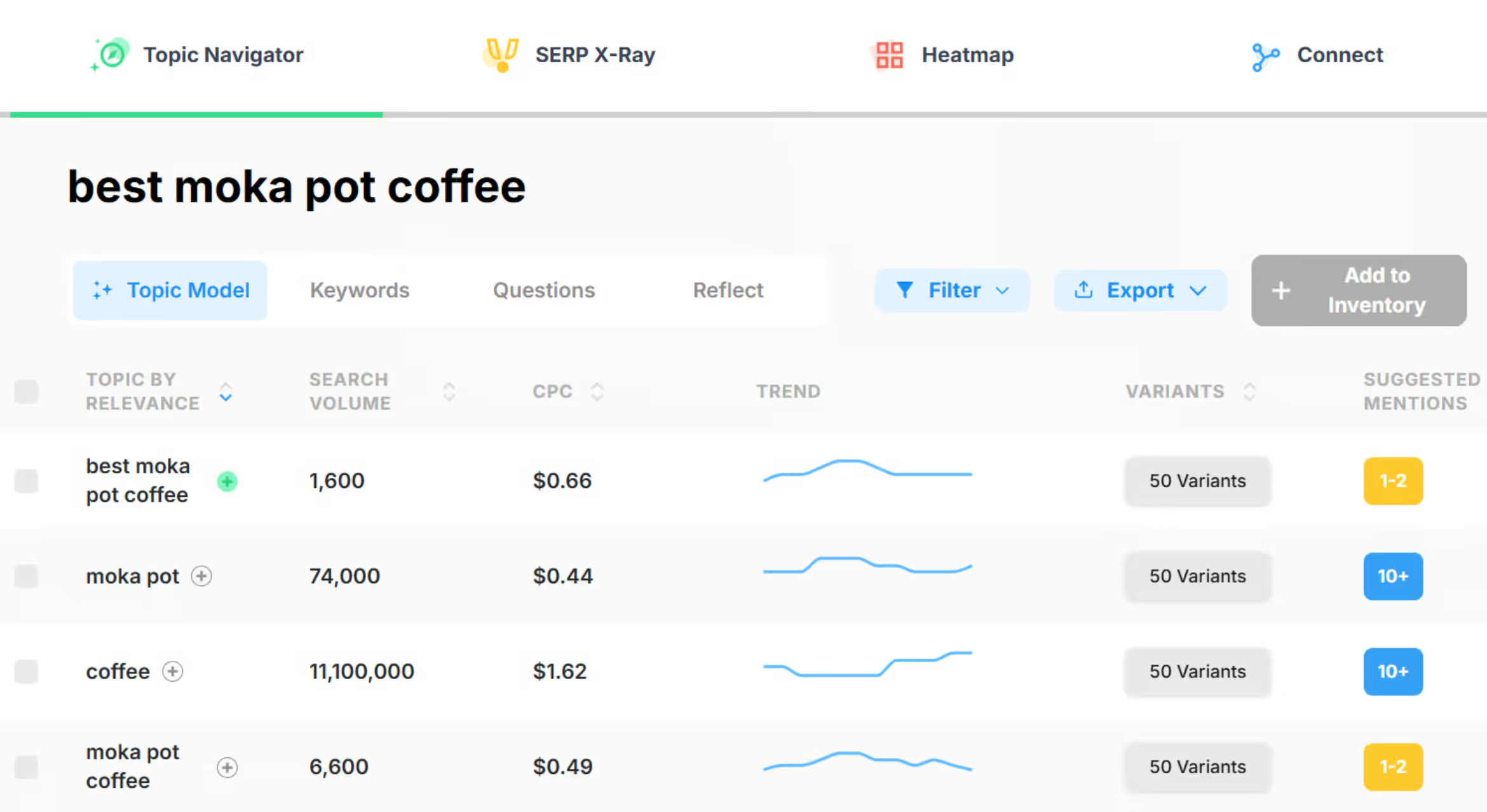
The AI briefs are some of the most comprehensive available, giving writers a strong foundation to work from.
Where it falls behind is usability. Unlike Clearscope’s clean, straightforward editor, MarketMuse can feel heavy and complex.
It lacks real-time optimization feedback during writing, and there’s no automation for internal linking or updating SEO optimized content at scale. Combined with enterprise pricing, it’s often more tool than smaller teams need.
Best for: Enterprise content teams and SEO strategists who want deep competitive analysis and long-term content optimization tools—and have the resources to manage a more complex platform.
4. Content Harmony
Content Harmony is a research-first platform that appeals to teams who want structured workflows and strong pre-writing insights.
Instead of focusing mainly on in-editor optimization, it guides you through keyword research, content briefs, and intent analysis before you start writing.
This makes it a solid Clearscope alternative if your process relies heavily on planning and consistency rather than live optimization.
Main features:
- Content workflows – Step-by-step system for keyword research, brief creation, and drafting.
- Keyword reports – Show search volume, CPC, difficulty, and intent.
- Content grader – Rates your draft from Poor to Great based on topic coverage and readability.
- Research depth – Pulls questions and subtopics from Google’s People Also Ask, Reddit, Quora, and other sources.
- Promotion workflows – Generate supporting assets like social captions or emails.
Where Content Harmony shines is in brief creation and research depth. Its workflows keep the process structured and repeatable, which is valuable for agencies or teams scaling production across multiple writers.
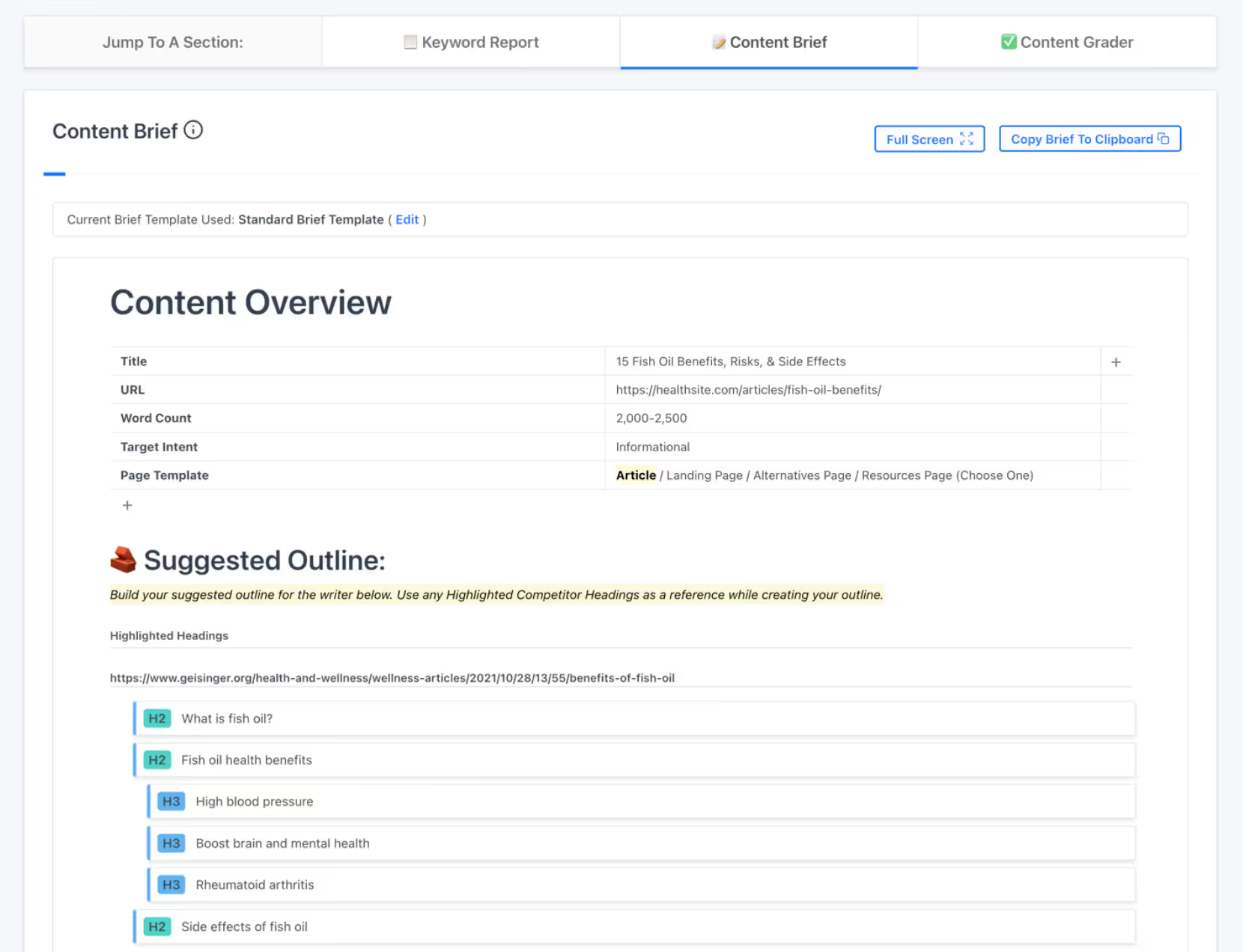
The ability to surface questions from forums and search queries adds useful topical coverage you might otherwise miss.
The trade-off is that it doesn’t offer much beyond research and briefs. There’s no real-time optimization in the editor, limited collaboration tools, and no automation for post-publish updates. Teams that want an all-in-one lifecycle solution will likely find it limited.
Best for: Content teams and agencies that value structured research, consistent briefs, and strong intent analysis to support writers at the start of the workflow.
5. Page Optimizer Pro (POP)
Page Optimizer Pro is a Clearscope alternative built with on-page SEO specialists in mind.
It leans less on sleek UI and more on delivering detailed recommendations around keyword usage, structure, and technical elements. For marketers who want granular control over optimization, it’s a strong contender.
Main features:
- SEO recommendations – Automated guidance on keyword usage, word count, schema, and on-page structure.
- Competitor analysis – Compare your page against top-ranking competitors, including schema and keyword strategies.
- POP Watchdog – Ongoing monitoring of SERP changes and ranking shifts triggered by algorithm updates.
- POP Schema – Helps create and implement structured data markup.
- POP EEAT – Evaluates content and site structure against EEAT (Experience, Expertise, Authoritativeness, Trustworthiness) standards.
POP’s strength is in its depth of recommendations. The reports go far beyond keyword lists, surfacing insights about schema usage, LSI terms, and content structure that influence rankings.
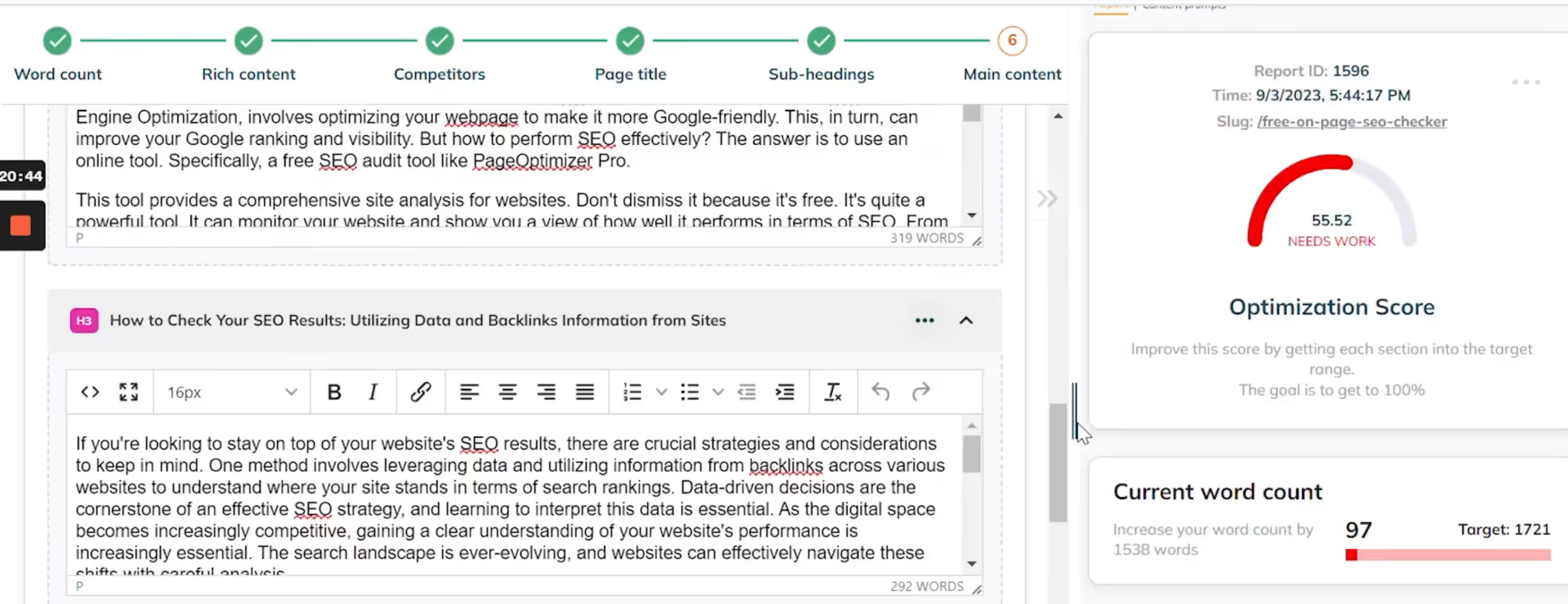
The competitor analysis is equally detailed, making it easier to see why certain pages rank higher. However, this level of detail comes at the cost of usability, especially regarding the user interface .
POP isn’t as intuitive as Clearscope, and it doesn’t provide real-time in-editor optimization, AI writing, or internal linking automation.
It’s better positioned as a tool for technical SEO experts than for content writers who want a straightforward editor.
Best for: Marketers and SEO professionals who want detailed on-page insights, competitor comparisons, and schema recommendations, not just surface-level keyword optimization.
6. Dashword
Dashword is a lightweight Clearscope alternative aimed at small teams and solo creators who want a straightforward content workflow.
It focuses on research, brief creation, and real-time optimization without overloading you with advanced features or complex dashboards.
Main features:
- Keyword research tool – Shows search volume, CPC, difficulty, and secondary keyword suggestions.
- Outline builder – Lets you pull headers from top-ranking pages and build structured briefs quickly.
- Content editor – Provides keyword suggestions, a content score, and readability tracking as you write.
- Question suggestions – Surfaces related questions to improve topical coverage.
- AI writing (basic) – Limited support for generating outlines or short sections.
Dashword’s appeal lies in its simplicity. The outline builder makes it easy to design briefs by pulling in competitors’ headings, while the built-in editor ensures writers stay aligned with SEO best practices. It’s clean, fast, and easy to learn.
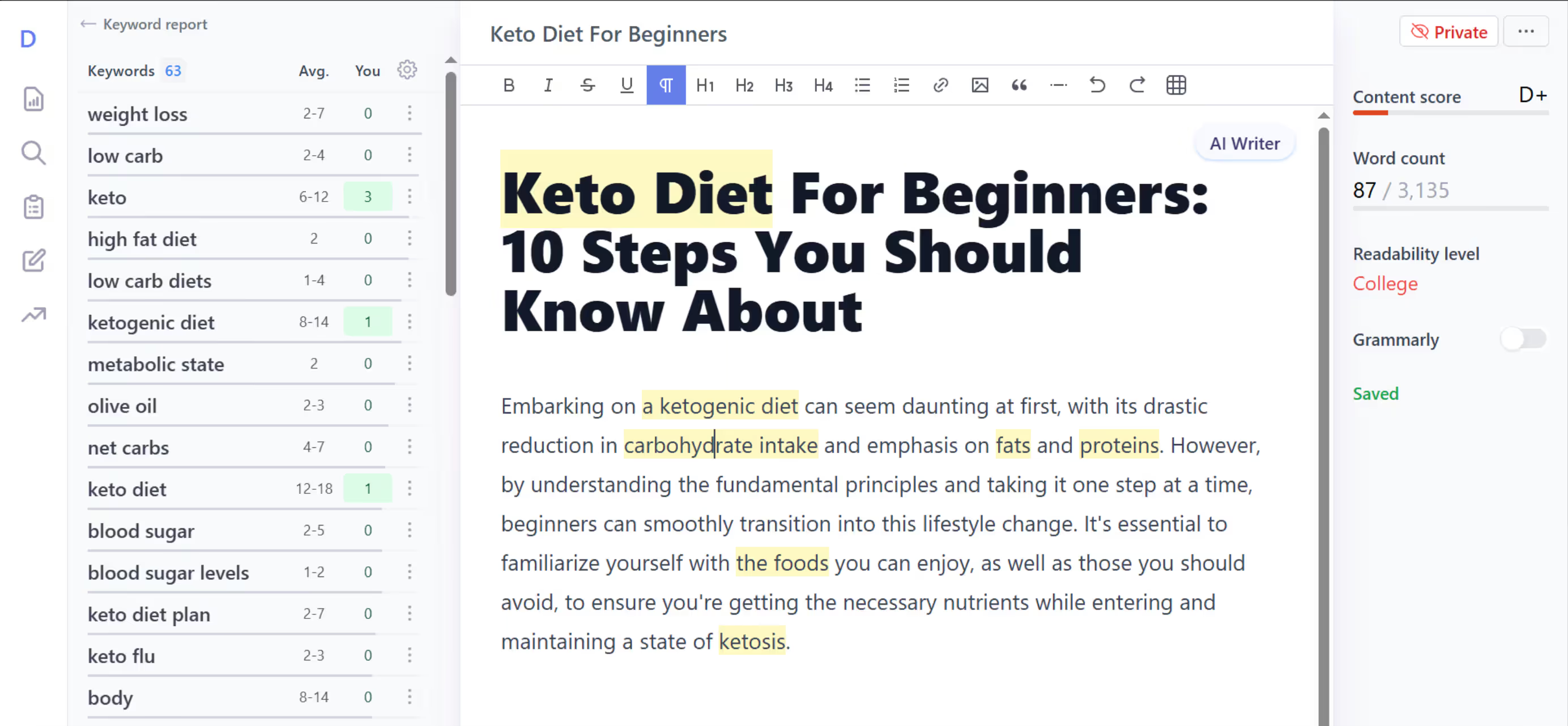
That said, Dashword doesn’t go very deep. There’s no topical mapping, advanced AI, or collaboration features, and the AI support is minimal compared to more full-featured platforms. Teams that need complex workflows or automation will likely outgrow it.
Best for: Small teams or individual creators who want a lean, easy-to-use content optimization tool that speeds up research and writing without added complexity.
7. Scalenut
Scalenut is an all-in-one Clearscope alternative that combines keyword research, content planning, and optimization into a single workflow.
It’s built for teams that want to scale content production quickly while keeping SEO structure in place.
Main features:
- Cruise Mode – Automatically generates SEO briefs and long-form drafts based on a seed keyword.
- Traffic Analyzer – Connects with Google Search Console to track impressions, CTR, and rankings.
- Content Optimizer – Provides real-time keyword, density, and formatting guidance.
- Internal link suggestions – Recommends connections between pages to strengthen clusters.
- Free SEO tools – Includes utilities like sitemap generators and minifiers.
What stands out about Scalenut is its automation-first approach. Cruise Mode can produce a draft that incorporates top-ranking insights, FAQs, and suggested links in minutes. For teams producing content at scale, that speed can make a big difference.
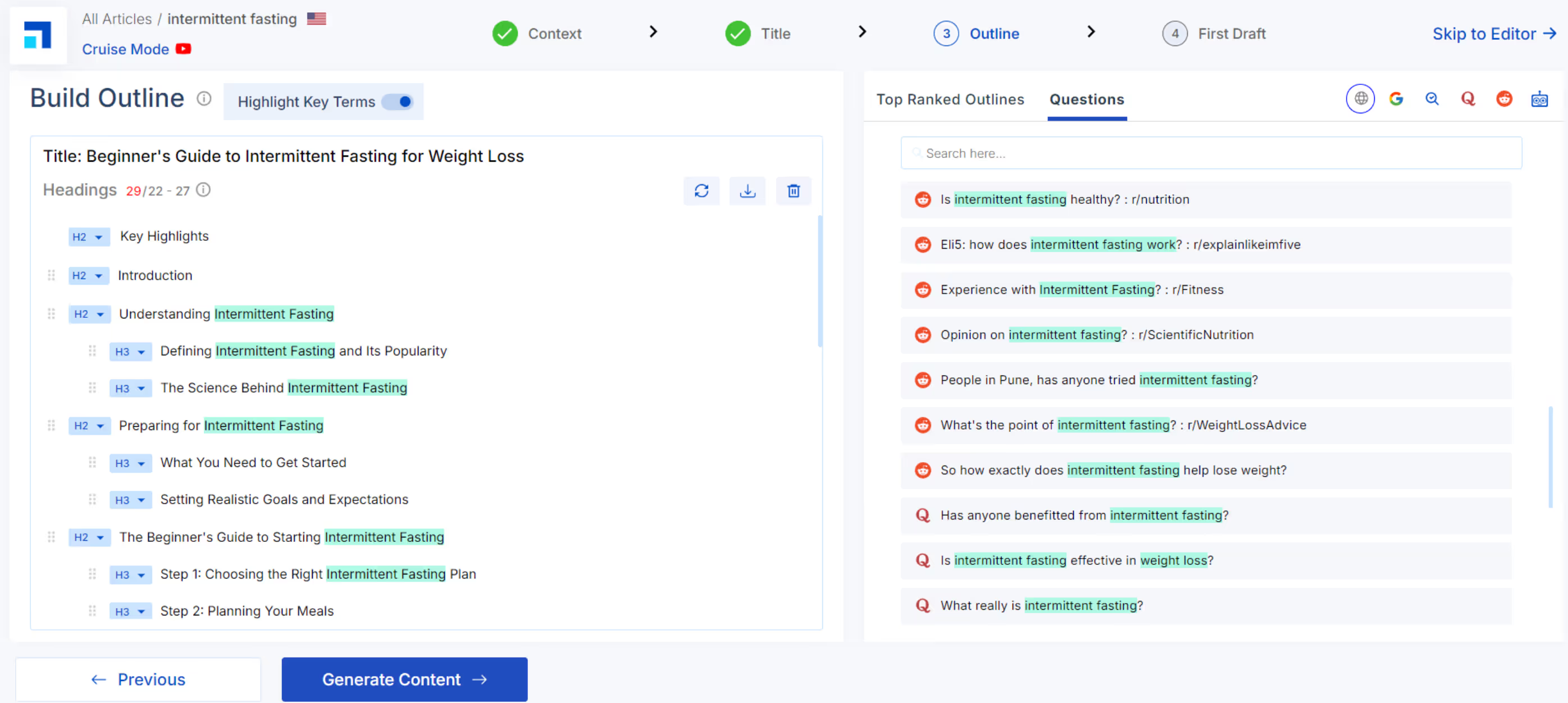
The downside is the interface and workflow, which can feel cluttered and unintuitive compared to Clearscope’s simplicity. There’s a learning curve, and some users report friction moving between modules.
Still, if you want a platform that blends AI writing, optimization, and performance tracking in one place, Scalenut offers more breadth than Clearscope.
Best for: Teams looking for an affordable, AI-driven platform to speed up production and manage SEO optimization across the full content lifecycle.
8. Outranking
Outranking is a Clearscope alternative that leans heavily on AI-assisted research and drafting.
It’s designed to help you move from keyword to structured outline to optimized draft quickly, while layering in data-driven insights along the way.
Main features:
- SERP analysis – Identifies secondary keywords, statistics, tables, and list items from top-ranking pages.
- AI writing – Generates titles, outlines, and full article drafts using competitor-backed insights.
- Content editor – Tracks keyword coverage, optimization score, and readability.
- Internal linking – Integrates with Google Search Console to suggest links between pages.
- Competitive analysis – Breaks down how ranking pages are structured and optimized.
Where Outranking stands out is in its structured approach to AI writing. Instead of simply generating text, it pulls research directly from competitors and weaves it into outlines or drafts. This makes the output more aligned with what’s already performing in search.
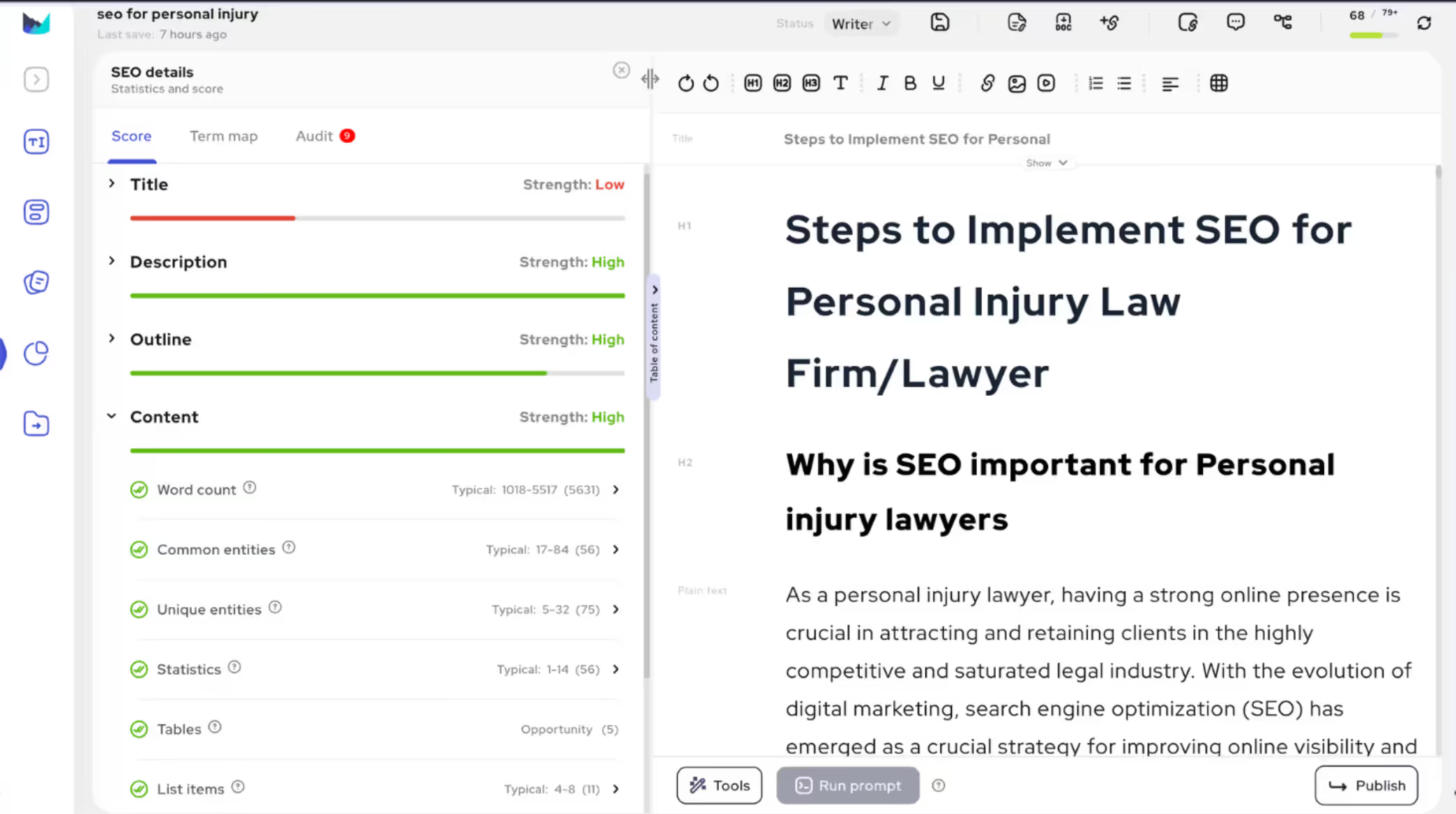
It does, however, take longer to set up compared to simpler tools like Clearscope. The interface is packed with options, and the AI writing still requires editing to fit brand voice and flow. But if you want an SEO tool that helps you optimize content by blending SERP-driven research with AI drafting, Outranking is a strong choice.
Best for: Content teams that want an AI-powered tool with detailed SERP insights to speed up content creation while staying aligned with competitors.
9. Rankability
Rankability is a lightweight Clearscope alternative aimed at small teams that want a clean, easy-to-use content optimization platform without enterprise complexity.
It covers the basics—keyword research, editing, and performance monitoring—inside a straightforward dashboard.
Main features:
- Keyword research – Surfaces relevant terms with volume, CPC, trends, and difficulty filters.
- Content editor – Optimizes drafts or imported content with keyword usage and structural guidance.
- Rankability score – Proprietary scoring system that tracks how well your page aligns with target keywords.
- Content monitoring – Visual charts to track the performance of published pages.
- Brief generation – AI-powered briefs with competitor-inspired outlines and common questions.
Rankability’s biggest advantage is accessibility. The interface is uncluttered, and you can quickly move from keyword to brief to editor without a steep learning curve.
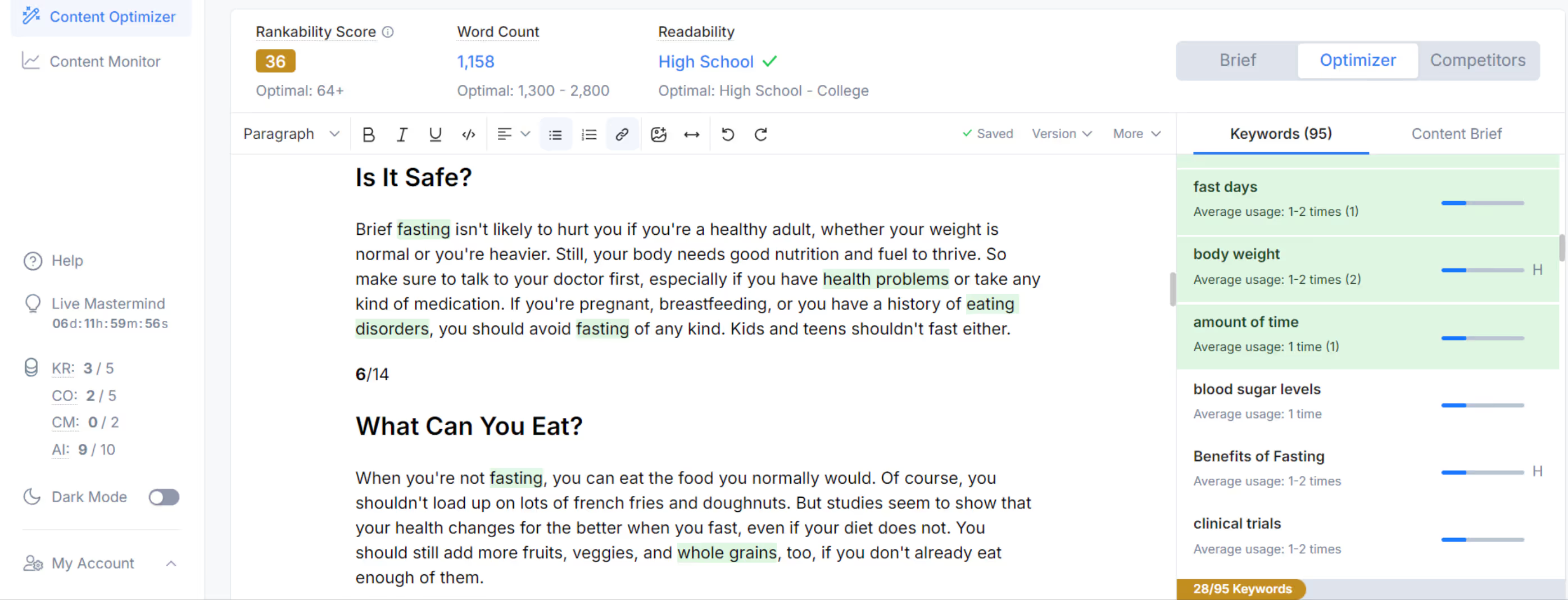
The content monitoring adds extra value for teams that want to see how published pages align with their optimization goals.
On the flip side, Rankability is limited in scope. It doesn’t offer topic modeling, internal linking automation, or deep AI writing features. The credit-based pricing model can also feel restrictive if you’re producing large volumes of content each month.
Best for: Smaller teams and solo creators who want a lightweight, beginner-friendly optimization tool for on-page improvements and performance tracking.
10. Semrush Writing Assistant
Semrush Writing Assistant is a Clearscope alternative built as part of the broader Semrush SEO suite.
Instead of offering a full content lifecycle, it functions as a lightweight optimization layer that integrates directly into the tools most teams already use, like Google Docs, WordPress, and Microsoft Word.
Main features:
- Platform integrations – Available as an add-on for Google Docs, MS Word, and WordPress.
- SEO checks – Tracks keyword presence, heading usage, alt text, and link issues.
- AI writing assistant – Suggests rewrites and edits to improve clarity and engagement.
- Content scoring – Evaluates SEO, readability, tone, and originality in real time.
- Plagiarism checker – Flags duplicate content to maintain originality.
The Writing Assistant is best seen as an SEO checklist companion. It helps polish drafts by checking whether they hit target keywords, follow readability guidelines, and maintain a consistent tone.
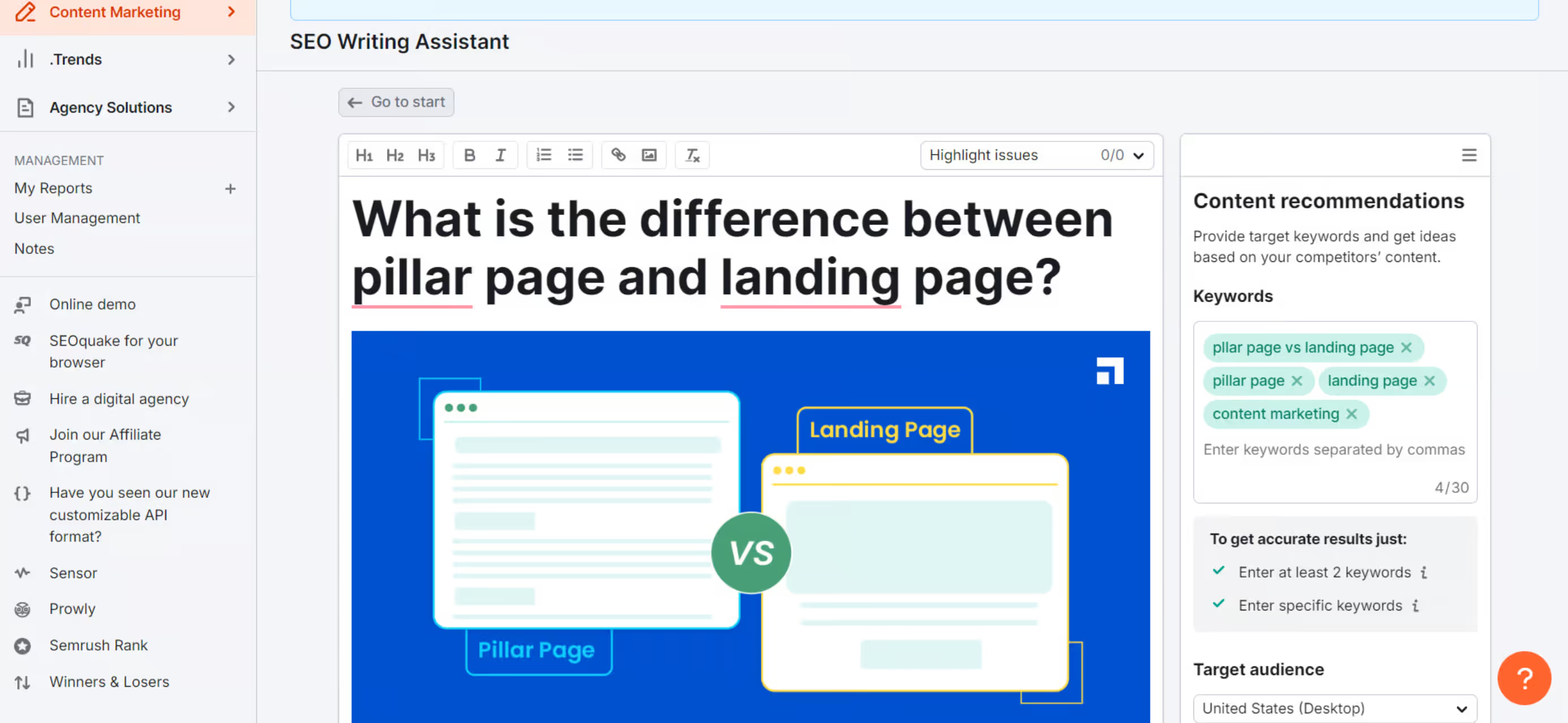
For existing Semrush users, it slots neatly into the workflow without requiring a separate platform.
The limitation is scope: it doesn’t generate full content briefs, perform in-depth SERP analysis, or provide automation for tasks like internal linking.
It’s not a replacement for full-scale content optimization platforms but rather a complementary tool for improving drafts.
Best for: Writers and teams already using Semrush who want a simple, integrated tool to tighten up SEO and readability inside their existing workflows.
Overview of top Clearscope alternatives
Choosing the best Clearscope alternative
The right Clearscope alternative depends on your goals, team size, and how deeply you want to integrate SEO into your content process.
If you’re a freelancer or small team, tools like Frase, Dashword, or Rankability give you affordable, easy-to-use workflows for getting optimized content out the door quickly.
If you need strategic depth, MarketMuse and Content Harmony offer stronger inventory analysis, topic modeling, and brief creation to guide long-term content planning.
For AI-driven speed and scale, platforms like Scalenut, Outranking, and Semrush Writing Assistant combine content generation with optimization features, helping teams publish more without sacrificing structure.
And if you want a platform that ties it all together — from planning to writing to optimization, internal linking, and performance monitoring—Surfer is the most comprehensive Clearscope alternative.
With proven ranking correlation, automation, and even AI search visibility tracking, it’s designed for teams focused on measurable results.
Ready to move beyond surface-level optimization?
.avif)

